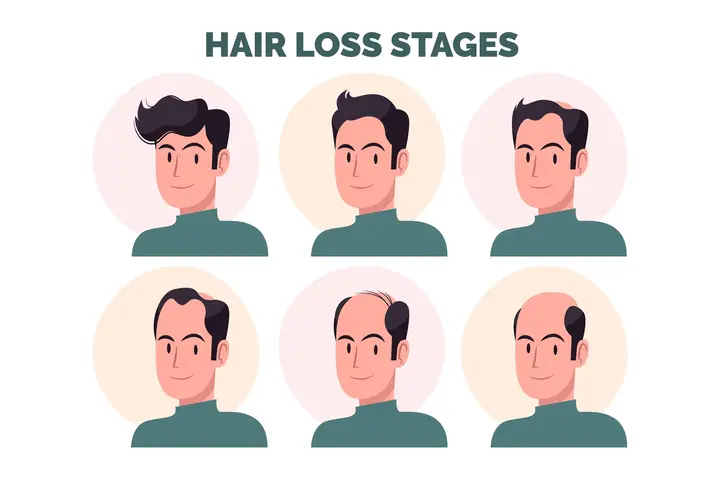What is Male Pattern Hair Loss?

Male pattern hair loss is the hair loss in the area from the top of the head to the temples. Male pattern hair loss is first seen in the top region. The hair begins to weaken at the hairline. The balding becomes more visible as the hairline and crown of the head begin to lose hair. Male pattern baldness at the front and top then begins to merge. Only the hair on the side and back of the head remains. At the end, the upper and middle part of the person’s head remains bald.
In addition to that, male pattern baldness can alsobe witnessed women. Keep reading to find out more about male pattern hair loss, the factors that affect it, its prevention and treatment.
Factors That Affect Male Pattern Baldness
It is undeniable that genes affect baldness the most. However, besides genetics, there are various factors that affect male pattern baldness in women and men such as:
- Diet
- Age
- Health
- Hormonal changes
- Stress, anxiety, depression
- Environmental changes
If you want to maintain healthy and nourished hair, it is vital to make sure you are consuming healthy food and leading a lifestyle with no stress or anxiety. Mental disorders such as depression, anxiety and stress are the biggest contributor to hair loss as they disrupt the oxygen supply and blood flow to scalp leading to male pattern hair loss. Hence, make sure you lead a healthy lifestyle and consume a healthy diet.
What percentage of men experience male pattern hair loss?
Unlike women, men begin to experience baldness in early adulthood. The baldness first appears on the hairline when it begins to recede. In the younger generations, baldness did not occur until 30s. However, the new generation is more vulnerable to hair loss and baldness due to excessive stress. After the hairline, the hair loss goes back to the temples and eventually the crown.
In general, 20% men will experience some type of hair loss as they reach 20. By the time they reach 50, more than 85% men will face extreme hair loss. Signs of male pattern baldness are most of the times difficult to detect and people begin taking it seriously when most of the hair has already fallen out. The most common yet unnoticed symptom is receding hairline. This unnoticeable hair loss is called “invisible baldness.” It only gets worse with time if not treated properly.
How to prevent male pattern hair loss?
You can prevent male pattern baldness by following these steps:
- Proper nutrition: With proper nutrition, the rate of hair loss can be slowed down. Consuming nutrients rich in vitamins is useful for slowing the rate of hair loss. Moreover, drinking plenty of water will also work very well at this stage.
- No smoking: Smoking is very damaging for the hair. Smokers have extremely weak hair. Hence, if you want to prevent hair loss or are already suffering from hair loss, you should quit smoking.
- Chemicals and heat used for styling hair will accelerate hair loss. For this reason, you should keep your hair away from chemicals or heat in order to not accelerate your hair loss.
- Hair loss can be slowed down by making the necessary treatments. Shampoos and other products specially prepared for hair losswill slow down the hair loss.
There is no way to stop hair loss but there are some ways to slow down the rate. Care of nutrition, taking the necessary supplements and using products that slow down the hair loss will help for the time being but eventually your hair will fall out. Male pattern hair loss is a permanent condition. The only way to get rid of the bald image is to have hair transplant.
How to treat male pattern baldness?
In the case of male pattern baldness, new hair is not replaced. Therefore, any medications and similar treatments for hair re-growth do not work. Permanent hair loss is the only remedy for hair transplantation. Hair transplantation is the transplantation of the patient’s own healthy hair to the place where hair loss occurs. Hair transplantation stages are briefly described below.
- The hair of the patient is first analyzed in hair transplantation. The doctor will analyze the hair loss level, donor area, number of grafts for the transplant and so on. As a donor site, a non-male hair loss region is preferred. In this way, there is no possibility of shedding hair again.
- The surgeon will start the procedure with local anesthesia. In this way, you don't feel any pain during the operation.
- After that, the doctor will collect hair grafts from the donor area individually.
- The collected hair follicles are left to be transplanted.
- Necessary channels are opened for planting the roots collected in the region where hair loss occurs.
- The doctor will then transfer the roots to these channels.
- Donor area is bandaged and transplant is completed.
- The first three days after transplanting, you should not touch your hair and let the experts carry out the first wash at the hair transplantation center.
You might also be interested in:
- Factors That Affect Male Pattern Baldness
- What percentage of men experience male pattern hair loss?
- How to prevent male pattern hair loss?
- How to treat male pattern baldness?
Contents
- Dental Treatment
- Hair Transplant
- Plastic Surgery
Categories
- Dental Treatment
- Hair Transplant
- Plastic Surgery


























